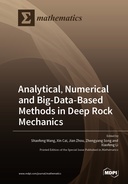Explore

Analytical, Numerical and Big-Data-Based Methods in Deep Rock Mechanics
0 Ungluers have
Faved this Work
Login to Fave
With the increasing requirements for energy, resources, and space, numerous rock engineering projects (e.g., mining, tunnelling, underground storage, and geothermal and petroleum engineering) are more often being constructed and operated in large-scale, deep underground, and complex geology environments. Meanwhile, more and more unconventional rock failures and rock instabilities (e.g., rockbursts, large-scale collapses, and mine earthquakes) are occurring and severely threatening the safety of underground operations. It is well-recognized that rocks have multiscale structures from minerals, particles, fractures, fissures, joints, and stratification to faults and involve multiscale fracture processes. In the deep earth, rocks are commonly subjected to complex high-stress and strong-dynamic disturbances simultaneously. In addition, there are many multiphysics coupling processes, such as the coupled thermo-hydromechanical interaction in fractured porous rocks. It is still difficult to understand rock mechanics and to characterize rock behaviors with complex stress conditions, multiphysics processes, and multiscale changes. The primary aim of this Special Issue is to bring together original research discussing innovative efforts on analytical, numerical, and big-data-based methods in rock mechanics. It includes 25 manuscripts that illustrate the richness and challenging nature of deep rock mechanics.
This book is included in DOAB.
Why read this book? Have your say.
You must be logged in to comment.
Rights Information
Are you the author or publisher of this work? If so, you can claim it as yours by registering as an Unglue.it rights holder.Downloads
This work has been downloaded 70 times via unglue.it ebook links.
- 70 - pdf (CC BY) at Unglue.it.
Keywords
- acoustic emission
- b value
- backfilled stopes
- bayesian optimization
- beetle antennae search algorithm
- Bingham slurry
- blind shaft cutting blasting
- BP neural network
- brittle-ductile transition
- chemical-stress coupling factor
- closed-form solution
- Coal
- complex variable method
- concrete part
- conformal mapping
- Copula function
- crack
- damage constitutive model
- data-driven approach
- deep forest
- deep mining
- deep rock mechanics
- DEM numerical simulation
- deterioration characteristics
- diffusion model
- DPM parameters
- Drucker–Prager model
- energy dissipation features
- ensemble model
- expansion ratio
- extremum entropy
- failure modes
- fault
- fractured aquifer
- fractured rock mass
- GA-SVM
- generalized probability density evolution method
- genetic algorithm
- geosynthetic-reinforced soil structures
- grade variable
- grout diffusion model
- grouting amount
- grouting effect
- heat-concentrated source
- high concrete face rockfill dam
- History of engineering & technology
- jointed rock mass
- laterally loaded pile
- lithology
- matter–element extension
- MEA-BP model
- mechanical and damage behaviors
- mechanical behavior
- Mechanical properties
- mind evolutionary algorithm
- mine slope
- mining advancing direction
- mining disturbance
- multifield coupling
- n/a
- Numerical methods
- Numerical Simulation
- optimization of heat source location
- orthogonal test method
- parameter optimization
- polymer
- p–y curve
- random forest
- Reactive transport
- Regression analysis
- Reliability
- reliability analysis
- RF
- rock burst
- rock damage judgment criteria
- rock drillability
- rock mechanical parameters
- rockburst classification
- rockburst prediction
- rough-walled fracture
- seismic performance
- slide–pipeline interaction
- slurry diffusion distance
- smooth wall blasting
- soil-pile interface
- SPH
- stability classification of rock mass
- strain rate
- strength reduction
- stress analytical solution
- stress evolution
- stress redistribution
- submarine pipelines
- submarine slides
- supervised learning
- t-SNE
- Technology, engineering, agriculture
- Technology: general issues
- temperature difference
- temperature effect
- temperature gradient
- triangle interpolation
- true triaxial compression test
- UCS prediction model
- unsupervised learning
- uranium-containing solution
- variable weight theory
- water inrush
- XGBoost
- zonal disintegration
Links
DOI: 10.3390/books978-3-0365-5762-5Editions

